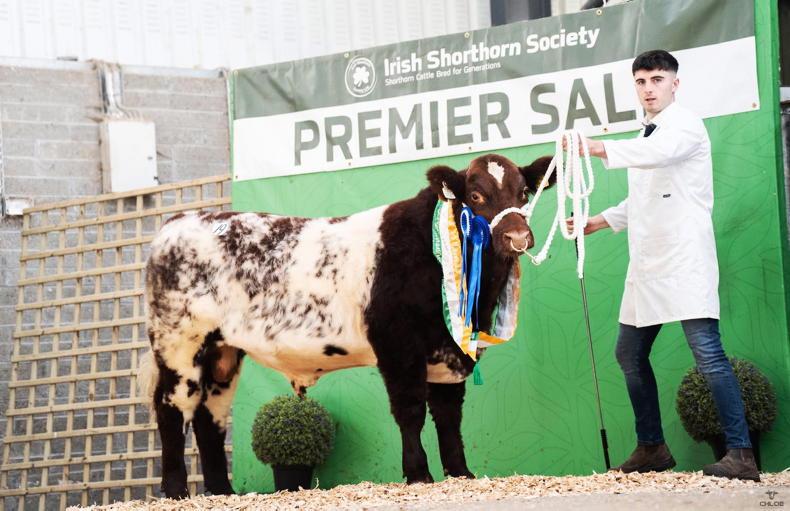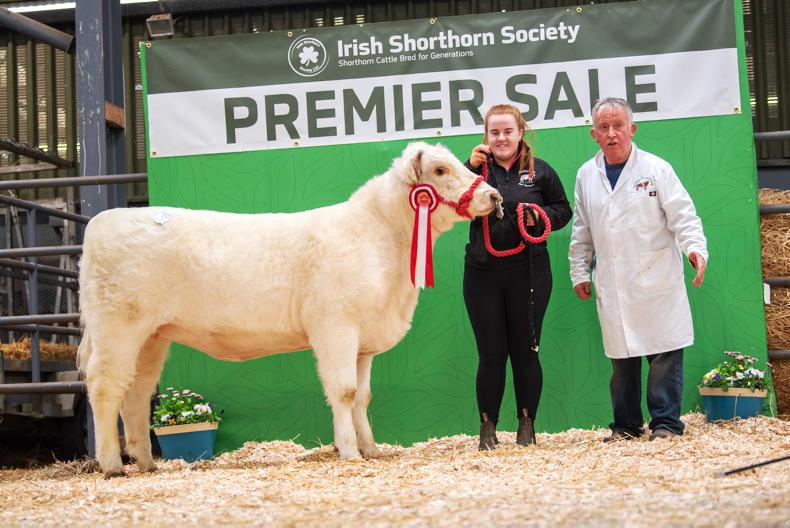Not far from Cookstown, Co Tyrone, lies the farm of Bronagh O’Kane. The 38-acre holding, bought originally by her grandfather, is centred around an eclectic cluster of farm buildings.
It’s a lovely setting on a cold spring evening, the spaciously-accommodated cattle and sheep, contentedly munching their way through haylage forked out to them by Bronagh and her father Paddy.
Bronagh really only began farming full-time in 2020, as her father approached retirement.
She is a wonderfully enthusiastic, reflective – and occasionally frustrated – proponent of regenerative farming and admits to being “a bit thick” about making good soil out of bad. The land here is very wet, with little or no sand content, resulting in sticky soils with a natural propensity for growing rushes, so she has her work cut out for herself – but does seem to be well-up for the challenge.
Challenging times
One of Bronagh’s first farming changes was to sell off most of the heavy pedigree Charolais cows previously favoured, replacing gradually with Shorthorns (crossed with an Angus bull) – lighter animals, less hassle and more suited to consuming the often-coarse vegetation.
She rears the calves to a year, but rues the loss of potential added value in having to sell so young.
Compounding the challenge of Bronagh’s early farming tenure was an unexpected and substantial contraction of the farm holding. From an original 120 acres, only 70 now remain, 38 owned.

Bronagh O’Kane on her farm.
Losing out on the recent sale of land which had been rented-in for years was a big blow; frustratingly the land is now used to service the needs of an anaerobic digestor.
The sudden loss of land forced Bronagh into sharply reducing stock numbers –from 85 head of cattle to 45 (23 cows), from 55 of her much-loved Charollais sheep to 20.
It also upended Bronagh’s other regenerative transition plans – to introduce longer rest periods for some fields, to reseed others with combicrops to boost soil health, and to replace chemical inputs with well-rotted manure. Difficult changes to introduce on a shrinking land base while trying to run a viable business.
Digging
Walking the farm with Bronagh, spade in hand and enthusiastic dog Rusty at foot, is a hands-on learning journey, as she reflects on the impact of her early efforts to improve soil health.

Bronagh’s worm farm. \ Bronagh O’Kane
Bronagh takes me to one field – her “worst” – where, last year, she topped-off the ubiquitous rushes, then ploughed and rotovated, before sowing a kickstarter combicrop, including flax, sunflower, chicory, clovers, vetch, westerwold grass and forage rape, all coated with homemade vermicast.
The outcome is (perplexingly) patchy yet, where the crops did take, the spade-full of upturned earth has a visibly better aggregated structure and several earthworms, positive signs of progress.
Waterlogged soils
Another field, once used for overwintering sheep, has compacted, waterlogged soils – in contrast to an adjacent field which, rested for a year, has seen a massive improvement in water filtration and soil aggregation.
A successful experiment for Bronagh, confirming for her the value of extended rest periods.
It’s clear that each field has lessons to offer and puzzles to solve, all part of Bronagh’s hands-on, crash-course, on-farm education.
Peer support
Dealing with these ever-present farming conundrums can be wearing, but fortunately, Bronagh also works off-farm, hosting a number of farmer discussion groups under the Growing Innovation Network (GrowIN) banner.
Here she works with colleagues like Helen Keys, Will Frazer and Dr Jim McAdam, to support farmers dealing with soil health, agroforestry and market gardening challenges.
While this role provides valuable off-farm income and a creative outlet, Bronagh feels that she herself benefits greatly from the advice and encouragement offered by her farming peers. The reverse is equally true – she can better empathise with other farmers having faced many of the same challenges herself. It can sometimes be stressful to keep moving forward she admits, making it harder to problem-solve, so the collegiality and practical advice help immensely.
Moving
Bronagh is justly proud of her farm and its heritage. The Ballinderry river flows by the farm, its clear water hosting freshwater pearl mussels and spawning salmon, thanks in no small part to her family’s custodianship of the land.
Bronagh has plans to create a pond and try agroforestry and has supplemented her existing, flourishing, hedgerows with new mixed-species hedges – less as stockproof boundaries, more as a future source of shelter and forage for cattle.

Bronagh with some of her Vermicast product. \ Bronagh O’Kane
Bronagh’s ambition is to stop farming for subsidies – Brexit leaves few options anyhow – and instead farm to suit the land.
Unlike many of us who just talk about the need for a ‘just transition’ for farmers, Bronagh is living through what is a genuinely tough transition, leaning on the support of her farming peers to do so. Ní neart go cur le Chéile.
Not far from Cookstown, Co Tyrone, lies the farm of Bronagh O’Kane. The 38-acre holding, bought originally by her grandfather, is centred around an eclectic cluster of farm buildings.
It’s a lovely setting on a cold spring evening, the spaciously-accommodated cattle and sheep, contentedly munching their way through haylage forked out to them by Bronagh and her father Paddy.
Bronagh really only began farming full-time in 2020, as her father approached retirement.
She is a wonderfully enthusiastic, reflective – and occasionally frustrated – proponent of regenerative farming and admits to being “a bit thick” about making good soil out of bad. The land here is very wet, with little or no sand content, resulting in sticky soils with a natural propensity for growing rushes, so she has her work cut out for herself – but does seem to be well-up for the challenge.
Challenging times
One of Bronagh’s first farming changes was to sell off most of the heavy pedigree Charolais cows previously favoured, replacing gradually with Shorthorns (crossed with an Angus bull) – lighter animals, less hassle and more suited to consuming the often-coarse vegetation.
She rears the calves to a year, but rues the loss of potential added value in having to sell so young.
Compounding the challenge of Bronagh’s early farming tenure was an unexpected and substantial contraction of the farm holding. From an original 120 acres, only 70 now remain, 38 owned.

Bronagh O’Kane on her farm.
Losing out on the recent sale of land which had been rented-in for years was a big blow; frustratingly the land is now used to service the needs of an anaerobic digestor.
The sudden loss of land forced Bronagh into sharply reducing stock numbers –from 85 head of cattle to 45 (23 cows), from 55 of her much-loved Charollais sheep to 20.
It also upended Bronagh’s other regenerative transition plans – to introduce longer rest periods for some fields, to reseed others with combicrops to boost soil health, and to replace chemical inputs with well-rotted manure. Difficult changes to introduce on a shrinking land base while trying to run a viable business.
Digging
Walking the farm with Bronagh, spade in hand and enthusiastic dog Rusty at foot, is a hands-on learning journey, as she reflects on the impact of her early efforts to improve soil health.

Bronagh’s worm farm. \ Bronagh O’Kane
Bronagh takes me to one field – her “worst” – where, last year, she topped-off the ubiquitous rushes, then ploughed and rotovated, before sowing a kickstarter combicrop, including flax, sunflower, chicory, clovers, vetch, westerwold grass and forage rape, all coated with homemade vermicast.
The outcome is (perplexingly) patchy yet, where the crops did take, the spade-full of upturned earth has a visibly better aggregated structure and several earthworms, positive signs of progress.
Waterlogged soils
Another field, once used for overwintering sheep, has compacted, waterlogged soils – in contrast to an adjacent field which, rested for a year, has seen a massive improvement in water filtration and soil aggregation.
A successful experiment for Bronagh, confirming for her the value of extended rest periods.
It’s clear that each field has lessons to offer and puzzles to solve, all part of Bronagh’s hands-on, crash-course, on-farm education.
Peer support
Dealing with these ever-present farming conundrums can be wearing, but fortunately, Bronagh also works off-farm, hosting a number of farmer discussion groups under the Growing Innovation Network (GrowIN) banner.
Here she works with colleagues like Helen Keys, Will Frazer and Dr Jim McAdam, to support farmers dealing with soil health, agroforestry and market gardening challenges.
While this role provides valuable off-farm income and a creative outlet, Bronagh feels that she herself benefits greatly from the advice and encouragement offered by her farming peers. The reverse is equally true – she can better empathise with other farmers having faced many of the same challenges herself. It can sometimes be stressful to keep moving forward she admits, making it harder to problem-solve, so the collegiality and practical advice help immensely.
Moving
Bronagh is justly proud of her farm and its heritage. The Ballinderry river flows by the farm, its clear water hosting freshwater pearl mussels and spawning salmon, thanks in no small part to her family’s custodianship of the land.
Bronagh has plans to create a pond and try agroforestry and has supplemented her existing, flourishing, hedgerows with new mixed-species hedges – less as stockproof boundaries, more as a future source of shelter and forage for cattle.

Bronagh with some of her Vermicast product. \ Bronagh O’Kane
Bronagh’s ambition is to stop farming for subsidies – Brexit leaves few options anyhow – and instead farm to suit the land.
Unlike many of us who just talk about the need for a ‘just transition’ for farmers, Bronagh is living through what is a genuinely tough transition, leaning on the support of her farming peers to do so. Ní neart go cur le Chéile.












SHARING OPTIONS